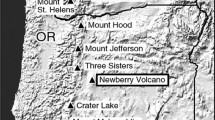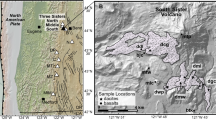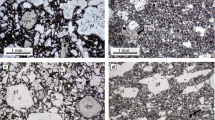Abstract
Glass Mountain consists of a 1 km3, compositionally zoned rhyolite to dacite glass flow containing magmatic inclusions and xenoliths of underlying shallow crust. Mixing of magmas produced by fractional crystallization of andesite and crustal melting generated the rhyolite of Glass Mountain. Melting experiments were carried out on basaltic andesite and andesite magmatic inclusions at 100, 150 and 200 MPa, H2O-saturated with oxygen fugacity controlled at the nickel-nickel oxide buffer to provide evidence of the role of fractional crystallization in the origin of the rhyolite of Glass Mountain. Isotopic evidence indicates that the crustal component assimilated at Glass Mountain constitutes at least 55 to 60% of the mass of erupted rhyolite. A large volume of mafic andesite (2 to 2.5 km3) periodically replenished the magma reservoir(s) beneath Glass Mountain, underwent extensive fractional crystallization and provided the heat necessary to melt the crust. The crystalline residues of fractionation as well as residual liquids expelled from the cumulate residues are preserved as magmatic inclusions and indicate that this fractionation process occurred at two distinct depths. The presence and composition of amphibole in magmatic inclusions preserve evidence for crystallization of the andesite at pressures of at least 200 MPa (6 km depth) under near H2O-saturated conditions. Mineralogical evidence preserved in olivine-plagioclase and olivine-plagioclase-high-Ca clinopyroxene-bearing magmatic inclusions indicates that crystallization under near H2O-saturated conditions also occurred at pressures of 100 MPa (3 km depth) or less. Petrologic, isotopic and geochemical evidence indicate that the andesite underwent fractional crystallization to form the differentiated melts but had no chemical interaction with the melted crustal component. Heat released by the fractionation process was responsible for heating and melting the crust.
Similar content being viewed by others
Author information
Authors and Affiliations
Additional information
Received: 26 March 1996 / Accepted: 14 November 1996
Rights and permissions
About this article
Cite this article
Grove, T., Donnelly-Nolan, J. & Housh, T. Magmatic processes that generated the rhyolite of Glass Mountain, Medicine Lake volcano, N. California. Contrib Mineral Petrol 127, 205–223 (1997). https://doi.org/10.1007/s004100050276
Issue Date:
DOI: https://doi.org/10.1007/s004100050276




